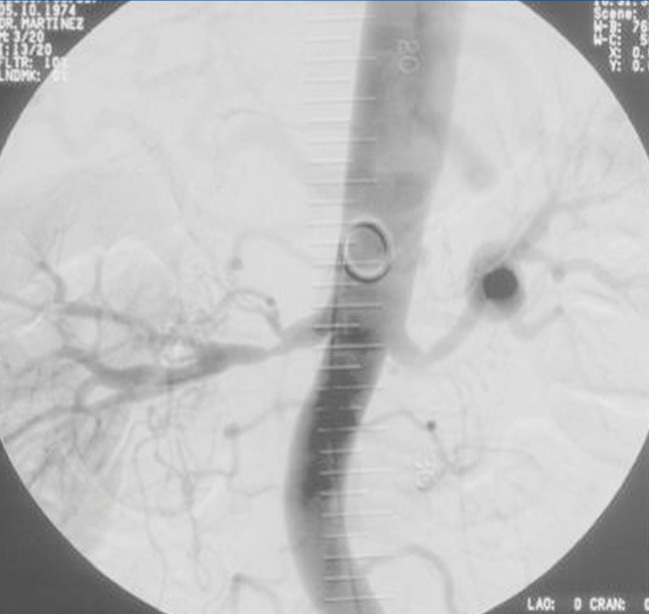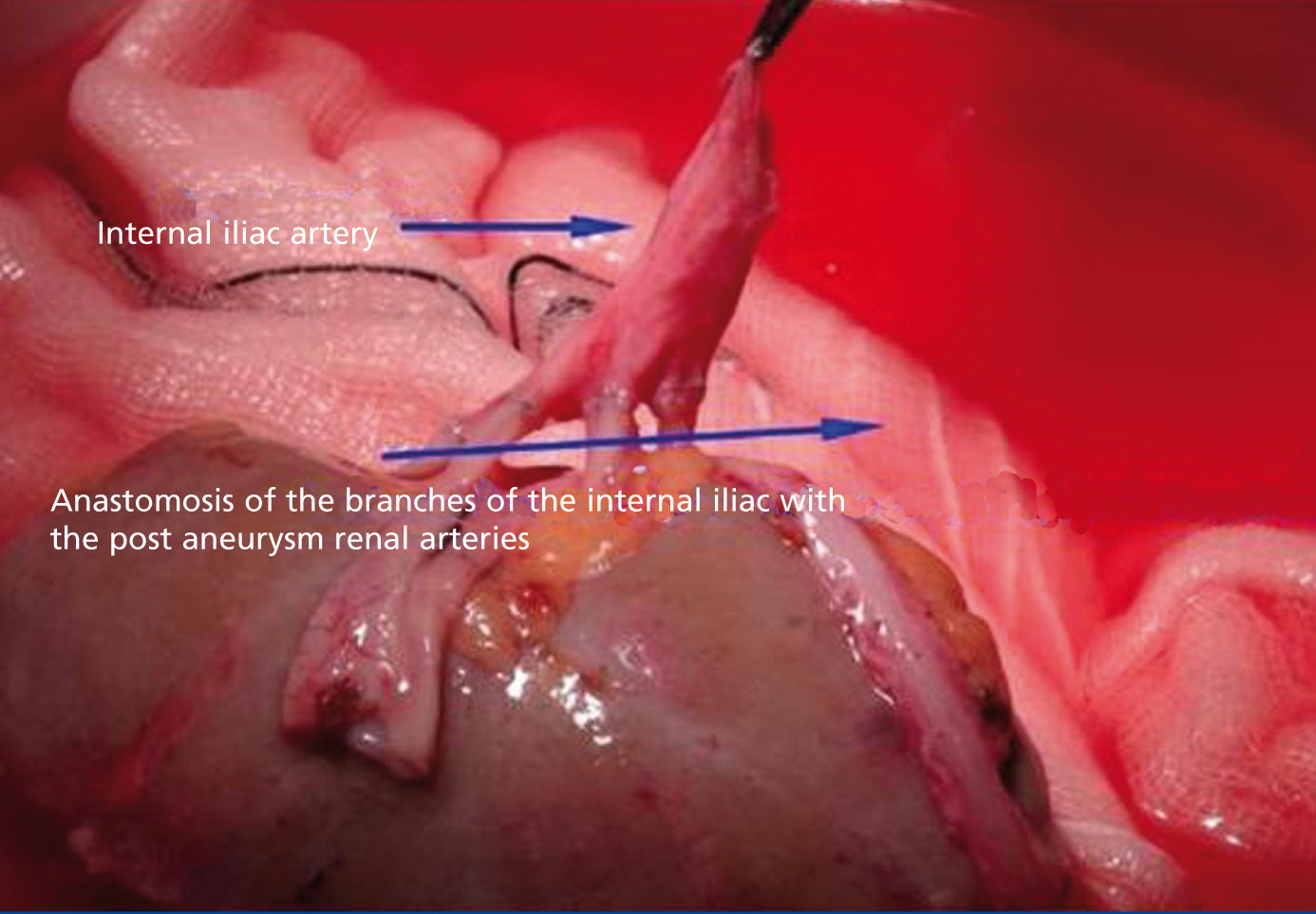Content
To the Editor:
Fibromuscular dysplasia (FMD) is occasionally accompanied by renal artery aneurysms. Percutaneous treatment is the treatment of choice in simple aneurysms and surgical treatment is reserved for complicated aneurysms and other selected cases.1
We report the case of a 36-year-old male, smoker, known as hypertensive for 20 years, who was monitored in our Hypertension Unit. During the year in which he was monitored, he had hypertensive emergency associated with headaches. Among the additional tests conducted, laboratory and eye fundus tests and renal ultrasound were normal. The echocardiography revealed a mild left ventricular hypertrophy with grade I diastolic dysfunction and the captopril test did not suggest renovascular hypertension (RVHT).
Five years later, he was admitted due to an episode of transient ischaemic attack in the context of a hypertensive emergency (210/130mmHg). At that time, the laboratory tests and renal ultrasound were normal and the eye fundus revealed a Keith-Wagener grade I hypertensive retinopathy. Since he was a young male with sustained high blood pressure (HBP) and frequent hypertensive emergencies, we wanted to rule out RVHT. The patient refused all forms of intervention and it was decided to continue ambulatory monitoring; optimal control of blood pressure (BP) was achieved with five drugs (irbesartan 300mg/day, hydrochlorothiazide 12.5mg/day, ramipril 5mg/12h, amlodipine 15mg/day, carvedilol 12.5mg/12h).
The following year, he suffered a subarachnoid haemorrhage after rupture of an aneurysm in the right superior cerebellar artery, making a full recovery after embolisation.
Subsequently, we observed a significant deterioration in renal function: creatinine (Cr) 3.7mg/dl, creatinine clearance (CrCl) 26.35 ml/min, which partially improved after discontinuation of the angiotensin converting enzyme inhibitor and the angiotensin II receptor antagonist. Given the suspicion of RVHT, a magnetic resonance angiogram was performed on the abdomen, confirming the presence of right renal artery stenosis 11mm from the ostium and an ovoid aneurysm in the final portion of the left renal artery, with a diameter greater than 1.8cm. Subsequently, renal arteriography was performed, in which we observed bilateral renal artery stenosis of probable fibromuscular dysplasia origin (Figure 1). Given these findings, bilateral percutaneous transluminal angioplasty was performed with ad integrum recovery of renal function: Cr 1mg/dl, CrCl 80ml/min and BP controlled with triple antihypertensive therapy (labetalol 300mg/day, amlodipine besylate 10mg/12h, torasemide 5mg/day).
Five years later, a follow-up renal ultrasound showed renal asymmetry, not previously observed (left kidney 8.5cm, right kidney 10cm), and therefore a computed tomography angiogram of the renal arteries was requested, confirming left renal artery restenosis, and the presence of an aneurysm on the right kidney of 1.5 x 1.2cm and the known aneurysm on the left side in an hourglass shape whose largest end measured 1 x 1.5 x 2.4cm. Furthermore, the ostium of 4 arterial branches was observed on the left side of the aneurysm. Given these findings, because it is an aneurysm with a complex anatomy, we ruled out the possibility of percutaneous treatment and the patient was taken to the Hospital Juan Canalejo de La Coruña for surgery. During the procedure, left laparoscopic nephrectomy and exeresis of a fragment of internal iliac artery with 4 arterial branches that had previously been selected in a lower limb angiogram were performed. Subsequently, in back table surgery the left renal artery aneurysm was resected in order to anastomose the 4 branches of the iliac artery with the 4 post aneurysm renal branches (Figure 2). Then the left kidney was autotransplanted to the patient's left iliac fossa. After surgery, renal function was normal (Cr 1.2mg/dl, CrCl 97ml/min) and BP was controlled with low-dose triple therapy (carvedilol 6.25mg/day, amlodipine 10mg/day, torasemide 2.5mg/day).
DISCUSSION
The arteries most frequently involved in FMD are renal (60%) and internal carotid (30-60%), although other arteries can also be involved, such as cerebral, vertebral, iliac, subclavian and visceral arteries.2,3 Renal artery aneurysms are diagnosed with a 0.7-1.3% incidence in renal angiograms. They may be asymptomatic, although they are generally associated with HBP (55%), haematuria (30%), flank pain (15%),1 etc. They can also be associated with renal artery stenosis and kidney failure. Surgical treatment is reserved for complex cases of aneurysms, major aneurysms of 2-2.5cm or when there is a progressive increase in their size. It is also indicated in cases of uncontrolled HBP, failed previous percutaneous treatment and when there are associated complications: renal artery thrombosis, haematuria due to rupture, renal infarction due to dissection or distal embolisation, etc.1,4,5 Surgery is also indicated in pregnancy, given the high risk of rupture, which could be fatal to both mother and foetus. Autotransplantation after aneurysm resection and ex vivo reconstruction is considered the treatment of choice in complex cases of aneurysms with multiple arterial anastomosis.1
CONCLUSION
Surgery in this case resulted in a considerable reduction in the number of antihypertensive drugs used, as well as the preservation of renal function and structural integrity.
Conflicts of interest
The authors declare that they have no conflicts of interest related to the contents of this article.
Figure 1. Angiogram
Figure 2. Back table surgery










